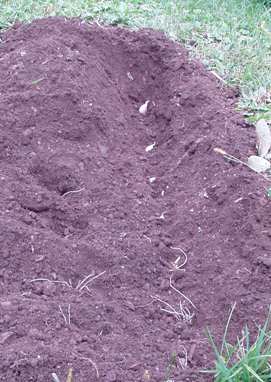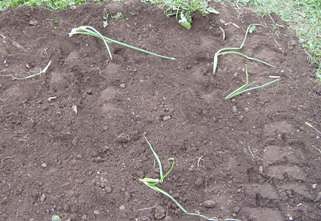 This morning, while the rest of the world (at least the part west of my time zone…) slept, your Aunt Toby was outdoors, miserably slumped on top of a too-small plastic bag, taking photographs of the frost.
This morning, while the rest of the world (at least the part west of my time zone…) slept, your Aunt Toby was outdoors, miserably slumped on top of a too-small plastic bag, taking photographs of the frost.
We had a BIG frost last night, though not what is called around here, a ‘killing’ frost, which is the one that causes all the moisture in the cells of the not hardy plants to freeze, expand (which is what moisture does when it freezes), explode the rigid cellular walls – and kill the plants. Last night’s frost was heavy for sure but not a killer frost. But that is coming. It’s coming.
But for the moment, we have some things left live and harvestable in the garden – the chard, the beets, the carrots, the onions, the cabbages. All of those (which are all pretty hardy) are still out there and your Aunt Toby is in her yearly battle between leaving the things in the garden as long as absolutely possible…and the deer. So far the score is Deer: 1, Chard leaves: 0. So, I’m going to harvest the rest of the chard ribs, cut off the deerly-beloved parts at the top, clean, blanch and freeze the chard for the winter.
Everyone knows I like chard, right?
But this is not about chard and deer. Today is about what I did in the garden today. Because today is all about the future. Gardeners are like baseball fans – we are all about planning for the future.
 Since we got such a big frost last night, I knew that it is time to get the garlic in the ground. I used to plant the garlic as soon as we got the onions harvested and I just loved to see the garlic come up in the fall and grow tall and green before the snow hit. Then someone who grows garlic for sale told me that I was handicapping the garlic by doing that – the bulb was putting out energy in the early fall growing leaves rather than settling down for the winter. Sure enough, I find that if we wait until the first good stiff frost, then we get much larger garlic bulbs the next year. Even if the garlic bulbs look a little bit weasly when it’s time, it works that way. So, patience is a virtue with garlic growing.
Since we got such a big frost last night, I knew that it is time to get the garlic in the ground. I used to plant the garlic as soon as we got the onions harvested and I just loved to see the garlic come up in the fall and grow tall and green before the snow hit. Then someone who grows garlic for sale told me that I was handicapping the garlic by doing that – the bulb was putting out energy in the early fall growing leaves rather than settling down for the winter. Sure enough, I find that if we wait until the first good stiff frost, then we get much larger garlic bulbs the next year. Even if the garlic bulbs look a little bit weasly when it’s time, it works that way. So, patience is a virtue with garlic growing.
 Garlic could not be easier:
Garlic could not be easier:
Dig up a patch of ground so that the dirt is nice and soft.
Dig a trench about the depth of your hand.
Break up the garlic bulb into cloves.
Every 4-6”, stick a garlic clove into the ground, flat end first (the leaves will come out the pointy end).
Cover them with about 6” of dirt and tamp down.
Voila.
Like all bulbs – tulips, daffodils, onions, etc. – the garlic may seem to be doing nothing but it is putting out roots from that flat bottom (the growth plate) and getting everything set for the spring. Then, when the ground freezes over, it goes dormant and wakes up when it starts to warm up. Then, it grows all summer and depending on what sort you have, will be harvestable when either a) the stalk falls down (soft neck garlic) or b) when the stalk dries out (hard neck garlic).
Could not be easier. Stick it in the ground, forget about it, watch it grow and harvest.
At the same time I was digging up the soil, I not only found lost garlics to replant, I also harvested some forgotten onions that we grew from teeny little plants this year. I’m not a big fan of onion plants – they usually arrive (as these did) all dried out, weasly looking and totally unpromising. As I suspected, they ended up not doing very well, so I culled out the worst looking ones, the ones that did not bulb up and so on and frankly, I made a trench and replanted them, spacing them out at 6” apart. They still have green leaves; they really are not ready to harvest. By replanting them, I gave them another chance. If they behave the way my other onions do which I’ve done this, they will send up nice young green onions in the spring, which will be real treat.
Why does this work? Well, even though Chez Siberia is in Upstate New York and our ‘frost free growing season’ is only 3-4 months long, the ground itself will not freeze until December. Just as I would plant flower bulbs at this point in the year, things like onions, garlic, shallots and so on (which are all members of the onion family, allium) can be planted now and wintered over. There are other things which can be held in this way, like carrots. If you have loose soil, you can mulch the plants heavily and hold the carrots in the soil until the soil freezes hard and you can’t get carrots out any longer. Once the soil starts to be difficult, it’s probably best at that point to dig up any root crops and put them into storage. Our best luck has been in drying or freezing root crops rather than trying to save them in a box of sand in the basement. Part of that is because we have a furnace, our basement does not stay cool in the winter – if you have an unheated attic or attached garage, it might be worth trying, though I’d do my best to make the box mouse-proof with wire screening and so on.
But the point is, there ARE some things that can be replanted if they don’t seem ‘done’ – such as onions, and there are some things which can be planted in the fall, such as garlic, and there are some things which can be held for a while, even into the winter – like cabbage, Brussels sprouts, kale and carrots. Don’t be in a hurry to get all your garden put to bed for the winter – you could be missing something.
